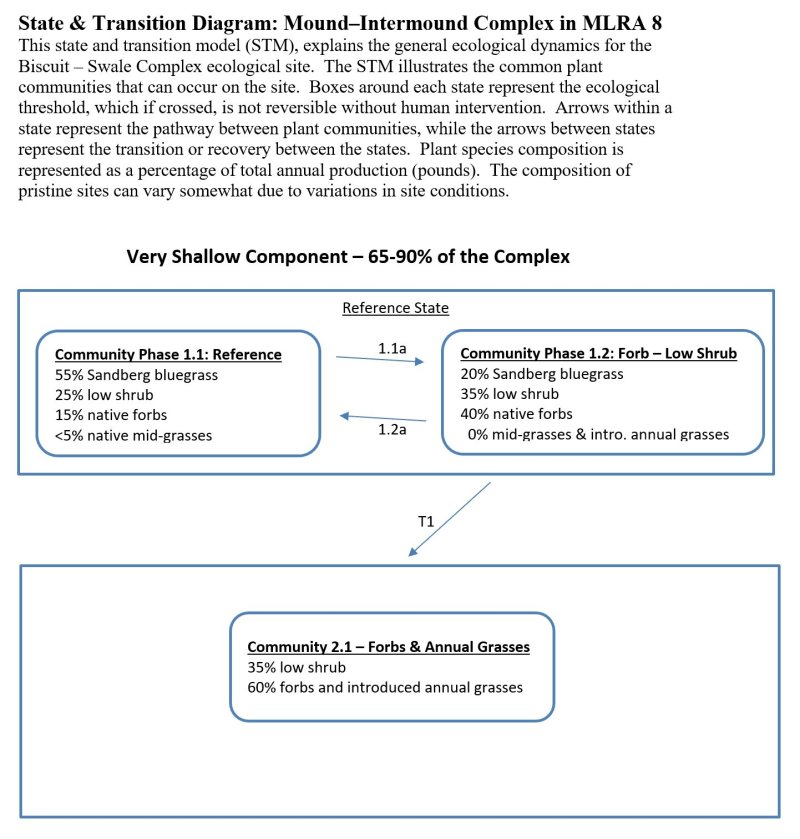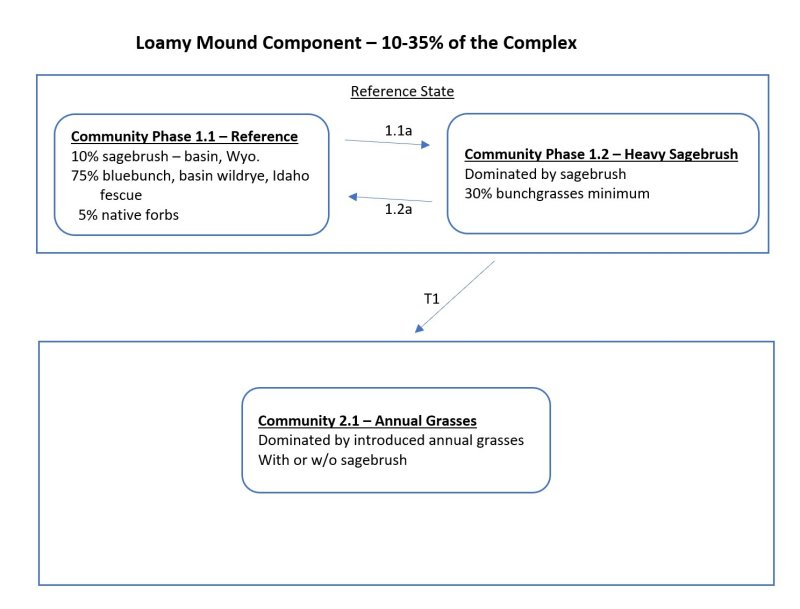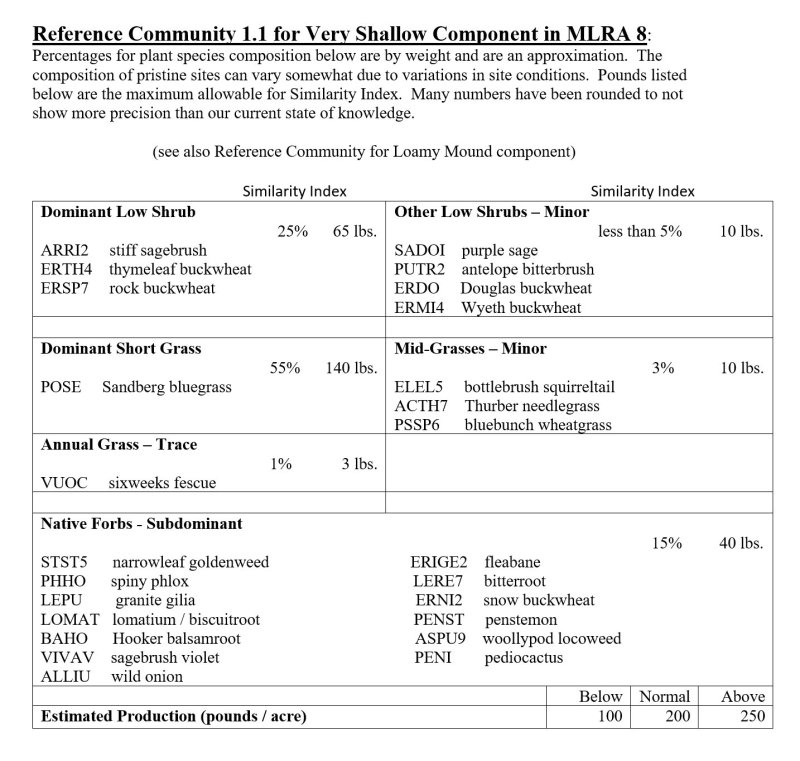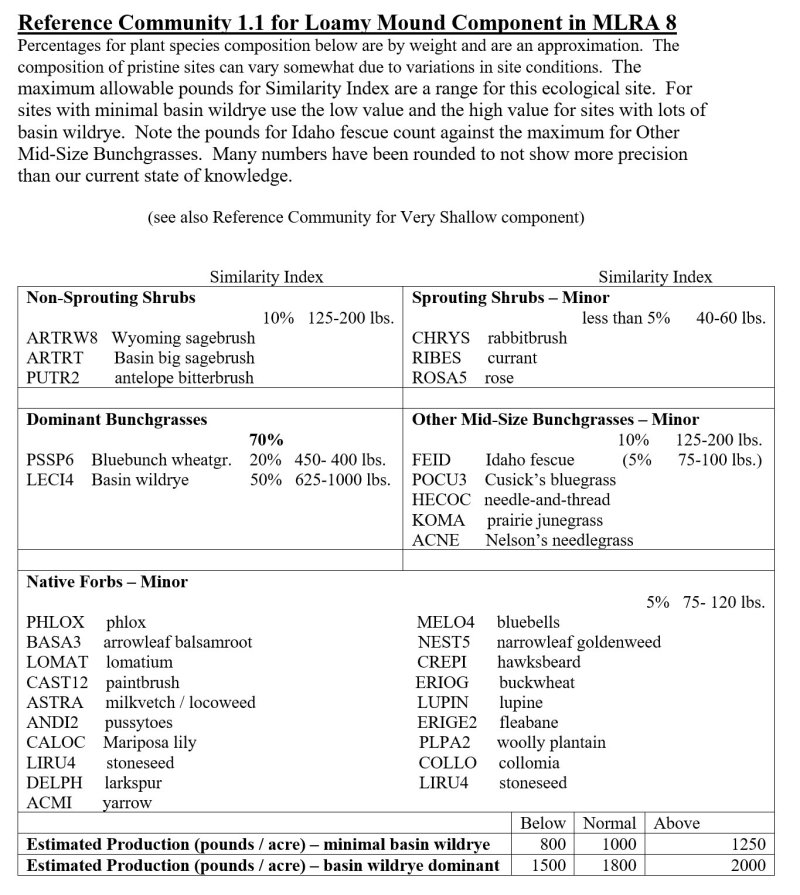Ecological site group R008XG002WA
Mound - Intermound Complex
Last updated: 09/21/2023
Accessed: 12/20/2025
Ecological site group description
Key Characteristics
None specified
Provisional. A provisional ecological site description has undergone quality control and quality assurance review. It contains a working state and transition model and enough information to identify the ecological site.
Physiography
Hierarchical Classification
Major Land Resource Area (MLRA): 8 – Columbia Plateau
LRU – Common Resource Areas (CRA):
8.1 - Channeled Scablands
8.2 - Loess Islands
8.3 - Okanogan Drift Hills
8.4 - Moist Pleistocene Lake Basins
8.5 - Moist Yakima Folds
8.6 - Lower Snake and Clearwater Canyons
8.7 - Okanogan Valley
Site Concept Narrative:
Mound-Intermound Complex has a mound, inter-mound topography. The Loamy Mound component is surrounded by the Very Shallow component, 65-90% Very Shallow and 10-35% Loamy Mound. Mounds are about 20-40 feet in diameter and one mound is separated from the next closest mound by about 50-100 feet.
The Very Shallow Component:
Very Shallow is a sparsely vegetated, low shrub-short grass, upland site on very shallow soils (generally less than 8 inches deep). Sandberg bluegrass is the short grass in all instances, but the low shrub component is variable. Stiff sagebrush is the most common low shrub, but one to several different buckwheat species are present on some sites, instead of, or with stiff sagebrush. The most common reference community is stiff sagebrush-Sandberg bluegrass.
Refer to the very shallow provisional ecological site for more specific information about the very shallow component.
The Loamy Mound component; moderately deep (20-40”) silt loam soil over basalt. In biscuit-swale topography, each silt loam mound is surrounded by very shallow ecological site.
Principle Vegetative Drivers:
• Very Shallow component – very shallow soil depth & the fracturing, or the lack of fracturing, in the underlying basalt bedrock.
• Loamy Mound component – deeper soil depth & intercepted moisture from adjoining Very Shallow immediately uphill of each mound
Influencing Water Features:
A plant’s ability to grow on a site and overall plant production is determined by soil-water-plant relationships:
1. Whether rain and melting snow runs off-site or infiltrates into the soil
2. Whether soil condition remain aerobic or become saturated and become anaerobic
3. Water drainage and how quickly the soil reaches wilting point
The lower part of the soil profile of Very Shallow has high clay content. With winter rain and melting snow, water perches and creates saturated conditions.
In wet years during spring runoff, water runs on the surface of the Very Shallow component for a short period. Even more water runs beneath the surface to sites below. This increases the effective precipitation to the adjacent sites below, including Loamy Mound.
Physiographic Features:
The landscape is part of the Columbia basalt plateau. Occurs on benches and terraces. For Very Shallow the soils are formed in loess and residuum weathered from basalt, while Loamy Mound have moderately deep, well drained soils formed in loess.
Physiographic Division: Intermontane Plateau
Physiographic Province: Columbia Plateau
Physiographic Sections: Walla Walla Plateau Section
Landscapes: Hills and plateaus
Landform: Intermounds, mounds, swales, hummocky areas, side slopes, terraces
Elevation: Dominantly 600 to 4,000 feet
Slope: Total range: 0 to 65 percent
Central tendency: 5 to 20 percent
Aspect: Occurs on all aspects
Geology:
This MLRA is almost entirely underlain by Miocene basalt flows. Columbia River basalt is covered in many areas with as much as 200 feet of loess and volcanic ash. Small areas of sandstones, siltstones, and conglomerates of the Upper Tertiary Ellensburg Formation are along the western edge of this area. Some Quaternary glacial drift covers the northern edge of the basalt flows, and some Miocene-Pliocene continental sedimentary deposits occur south of the Columbia River, in Oregon.
A wide expanse of scablands in the eastern portion of this MLRA, in Washington, was deeply dissected about 16,000 years ago, when an ice dam that formed ancient glacial Lake Missoula was breached several times, creating catastrophic floods. The geology of the northernmost part of this MLRA is distinctly different from that of the rest of the area. Alluvium, glacial outwash, and glacial drift fill the valley floor of the Okanogan River and the side valleys of tributary streams. The fault parallel with the valley separates pre-Tertiary metamorphic rocks on the west, in the Cascades, from older, pre-Cretaceous metamorphic rocks on the east, in the Northern Rocky Mountains. Mesozoic and Paleozoic sedimentary rocks cover the metamorphic rocks for most of the length of the valley on the west.
Climate
The climate is characterized by moderately cold, wet winters, and hot, dry summers, with limited precipitation due to the rain shadow effect of the Cascades. Taxonomic soil climate is either xeric (12 – 16 inches PPT) or aridic moisture regimes (10 – 12 inches PPT) with a mesic temperature regime.
Mean Annual Precipitation:
Range: 10 – 16 inches
Seventy to seventy-five percent of the precipitation comes late October through March as a mixture of rain and snow. June through early October is mostly dry.
Mean Annual Air Temperature:
Range: 44 to 54 F
Central Tendency: 48 – 52 F
Freezing temperatures generally occur from late-October through early-April. Temperature extremes are 0 degrees in winter and 110 degrees in summer. Winter fog is variable and often quite localized, as the fog settles on some areas but not others.
Frost-free Period (days):
Total range: 90 to 200
Central tendency: 110 to 160
The growing season for Loamy Mound is March through mid-July.
Soil features
Edaphic:
The Mound – Intermound Complex commonly occurs with rock outcrop, Stony Shallow and Stony ecological sites. Components of this complex are 65-90% Very Shallow and 10-35% Loamy Mound.
As an annual occurrence, Very Shallow soils become saturated, frost heave, and in wet years, water runs to sites below. Loamy Mounds receive additional water during this process. Refer to the Very Shallow PESD for a discussion regarding pedestaling.
Very Shallow sites are sensitive to soil disturbances. When the Very Shallow site is saturated and muddy, physical damage to the site – from vehicle ruts and hoof prints from cows, horses or deer for example – remain intact for many years.
Representative Soil Features:
This ecological site components are dominantly Lithic, Calcic, Cambidic, Vitritorrandic, and Calciargidic taxonomic subgroups of Haploxerolls, Durixerolls and Argixerolls great groups of the Mollisols taxonomic order, with Aridisols occurring as well. Soils are very shallow to deep. Average available water capacity of about 5.0 inches (12.7 cm) in the 0 to 40 inches (0-100 cm) depth range.
Soil parent material is dominantly mixed loess, colluvium and residuum.
The associated soils are Argabak, Bakeoven, Horseflat, Morrow, Stubblefield, Toler, Zen and similar soils.
Dominate soil surface is silt loam to very cobbly sandy loam, with ashy modifier sometimes occurring as well.
Dominant particle-size class is fine-silty to loamy-skeletal
Fragments on surface horizon > 3 inches (% Volume):
Minimum: 0
Maximum: 2
Fragments within surface horizon > 3 inches (% Volume):
Minimum: 0
Maximum: 25
Average: 10
Fragments within surface horizon ≤ 3 inches (% Volume):
Minimum: 0
Maximum: 30
Average: 10
Subsurface fragments > 3 inches (% Volume):
Minimum: 0
Maximum: 25
Average: 10
Subsurface fragments ≤ 3 inches (% Volume):
Minimum: 0
Maximum: 35
Average: 25
Drainage Class: Dominantly well drained
Water table depth: Greater than 60 inches
Flooding:
Frequency: None
Ponding:
Frequency: None
Saturated Hydraulic Conductivity Class:
0 to 10 inches: Moderately high and high
10 to 40 inches: Moderately high and high
Depth to root-restricting feature (inches):
Minimum: 4
Maximum: 60
Electrical Conductivity (dS/m):
Minimum: 0
Maximum: 20
Sodium Absorption Ratio:
Minimum: 0
Maximum: 5
Calcium Carbonate Equivalent (percent):
Minimum: 0
Maximum: 35
Soil Reaction (pH) (1:1 Water):
0 - 10 inches: 5.6 to 8.4
10 - 40 inches: 5.6 to 9
Available Water Capacity (inches, 0 – 40 inches depth):
Minimum: 0.5
Maximum: 9.0
Average: 5.0
Vegetation dynamics
Ecological Dynamics:
Very Shallow component (65-90%):
Very Shallow produces about 100-250#/acre.
The Very Shallow ecological site in MLRA 8 has at least four different variations on the low shrub-short grass theme for the Reference Community. Sandberg bluegrass is co-dominant in every variation:
1. Stiff sagebrush – Sandberg bluegrass
2. Stiff sagebrush / thyme-leaved buckwheat / rock buckwheat – Sandberg bluegrass
3. Thyme-leaved buckwheat – Sandberg bluegrass
4. Narrowleaf goldenweed (Stenotus s.) – Sandberg bluegrass
Refer to the Very Shallow description in site number R008XY001WA for more information about the Very Shallow component.
Loamy Mound component (10-35%):
Loamy Mound produces 1000# to 2000#/acre depending on the amount of basin wildrye present. Refer to the chart for Reference Community; production is listed in more detail.
In a space as small as 20-feet in diameter a single mound has three reference community situations:
1. North aspect has Idaho fescue
2. West, east and south aspects are Wyoming sage-bluebunch wheatgrass
3. The top of the mound has basin big sagebrush-basin wildrye
At higher elevations within MLRA 8 the Loamy Mound component may be predominately a basin wildrye site. But the Loamy Mound component is also quite variable. Adjacent mounds can vary – no sagebrush and with sagebrush, no basin wildrye and with basin wildrye, with saltgrass or no saltgrass.
Another very important disturbance is rodent activity on the Loamy Mound portion of this ecological site. Direct soil disturbances provide an opportunity for exotic invasive species to colonize the mound or to expand.
The vegetative cover on the Very Shallow component is too low to carry fire, so this ecological site rarely burns. In many pastures, due to surface rocks and limited forage, Very Shallow sites are not attractive to grazing animals and so are rarely if ever grazed. Based on inherent protection from both fire and grazing, most Very Shallow sites are stable.
For more grazing management information refer to Range Technical Notes found in Section I Reference Lists of NRCS Field Office Technical Guide for Washington State.
Note to planners for estimating forage for Mound – Intermound Complex:
1. Often Mound – Intermound Complex receives little to no livestock use. It is perfectly ok to indicate zero AUMs of forage from this ecological site
2. If the complex is being grazed, consider using the process below:
a. For the Mound – Intermound Complex polygon estimate the percentages for Very Shallow component and Loamy Mound component.
b. Percentages times acres of polygon will give acres of Very Shallow and acres of Loamy mound
c. Multiply AUM/acre times acres of Very Shallow for AUMs from Very Shallow
d. Multiply AUM/acre times acres of Loamy Mound for AUMs from Loamy Mound
Supporting Information:
Associated Sites:
Mound-Intermound Complex is associated with Very Shallow, and other ecological sites in the Sagebrush Steppe and Grassland Steppe portions of MLRA 8.
Similar Sites:
MLRA 7 Columbia Basin and MLRA 6 East Slope of the Cascades have a similar mound-intermound topography but this is much less extensive than MLRA 8 Columbia Plateau.
Inventory Data References (narrative):
Data to populate Reference Community came from several sources: (1) NRCS ecological sites from 2004, (2) Soil Conservation Service range sites from 1980s and 1990s, (3) Daubenmire’s habitat types, and (4) ecological systems from Natural Heritage Program
Major Land Resource Area
MLRA 008X
Columbia Plateau
Subclasses
Stage
Provisional
Contributors
Provisional Site Author: K. Guinn
Technical Team: K. Moseley, G. Fults, R. Fleenor, W. Keller, C. Smith, K. Bomberger, C. Gaines, K. Paup-Lefferts
Click on box and path labels to scroll to the respective text.



